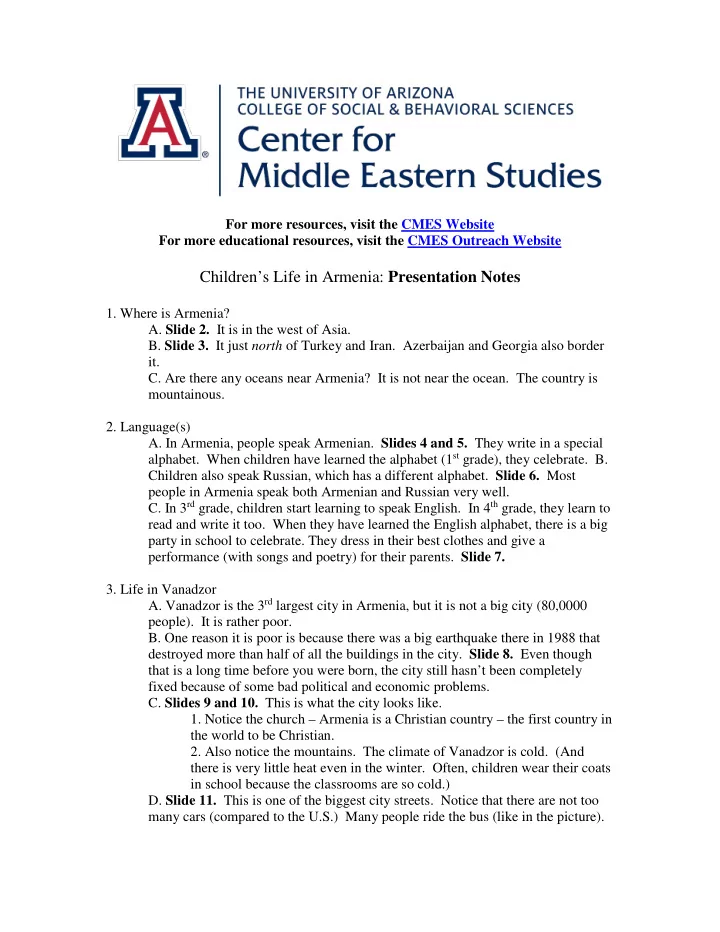

For more resources, visit the CMES Website For more educational resources, visit the CMES Outreach Website Children’s Life in Armenia: Presentation Notes 1. Where is Armenia? A. Slide 2. It is in the west of Asia. B. Slide 3. It just north of Turkey and Iran. Azerbaijan and Georgia also border it. C. Are there any oceans near Armenia? It is not near the ocean. The country is mountainous. 2. Language(s) A. In Armenia, people speak Armenian. Slides 4 and 5. They write in a special alphabet. When children have learned the alphabet (1 st grade), they celebrate. B. Children also speak Russian, which has a different alphabet. Slide 6. Most people in Armenia speak both Armenian and Russian very well. C. In 3 rd grade, children start learning to speak English. In 4 th grade, they learn to read and write it too. When they have learned the English alphabet, there is a big party in school to celebrate. They dress in their best clothes and give a performance (with songs and poetry) for their parents. Slide 7. 3. Life in Vanadzor A. Vanadzor is the 3 rd largest city in Armenia, but it is not a big city (80,0000 people). It is rather poor. B. One reason it is poor is because there was a big earthquake there in 1988 that destroyed more than half of all the buildings in the city. Slide 8. Even though that is a long time before you were born, the city still hasn’t been completely fixed because of some bad political and economic problems. C. Slides 9 and 10. This is what the city looks like. 1. Notice the church – Armenia is a Christian country – the first country in the world to be Christian. 2. Also notice the mountains. The climate of Vanadzor is cold. (And there is very little heat even in the winter. Often, children wear their coats in school because the classrooms are so cold.) D. Slide 11. This is one of the biggest city streets. Notice that there are not too many cars (compared to the U.S.) Many people ride the bus (like in the picture).
But usually people walk everywhere. Not every family has a car; hardly any family has more than one car. E. Shopping. 1. Slides 12 and 13. Many of the stores are outside. There is not very much to buy: clothes (most people wear black, white, and red), food, things for the house, music. Children LOVE video games, but most do not have a game system at home. Even grown-ups usually go to an internet center to use a computer. 2. Slide 14. This woman is baking a flat bread. Food is good, but people are not very rich, and some of them are hungry. There is no free breakfast or lunch at school, so many children do not have much to eat. If they eat lunch at school, they usually bring something – or they wait until they get home. 3. When you go shopping, you will see signs in 3 languages. Slide 15. 4. School A. Slide 16. Younger kids go to daycare and Kindergarten in buildings like this one. The school is next door (which is why the high school kids are playing keep- away in front of the younger kids’ building). The younger children’s playground is in back of the stone building, enclosed by a fence. B. Until this year, kids from grade 1-11 all went to school in the same building. Now Armenia is creating a separate high school in each town. When everything is done, grades 1-9 will be in one school; grades 10-12 in another. C. Slide 17. This is School #5 in Vanadzor. It used to have all grades, but now it is becoming the city’s high school. (The younger children and their teachers are being moved to other schools.) The school is very nice, by Vanadzor’s standards. It is a rather new building because during the earthquake of 1988, the old school was completely destroyed. (The teachers and students escaped as the building was collapsing.) D. Classrooms look like this - Slide 18 - except that there is one more row of 2- person desks to the right. Slide 19. Notice that many kids are wearing jackets inside – even though the picture was taken when the weather was getting warmer (in mid-April). E. Students in grades 1 – 3 have one teacher. But in grades 4 – 12, students have a different teacher for each subject. TEACHERS move from class to class, not the students. F. Children are expected to work hard in school. They study more subjects than American children, so teachers feel that there is no time to waste. If someone doesn’t know an answer, the teacher goes on to the next student (and the student who didn’t know the answer gets a bad grade). Children are expected to come to class prepared – they usually have plenty of homework. G. Students go to school SIX days a week (from Monday through Saturday). They only go for five hours every day (9:00 – 2:00) because they do not eat lunch at school.
H. Children learn many different subjects: English and Russian as well as Armenian reading and writing, art, math, sciences, social studies, etc. 5. In many ways, life is different in Armenia than here (compare and contrast). But KIDS are the same everywhere – people with hopes and dreams, people who like sports or music, people like you. Slides 20 – 23.
Recommend
More recommend